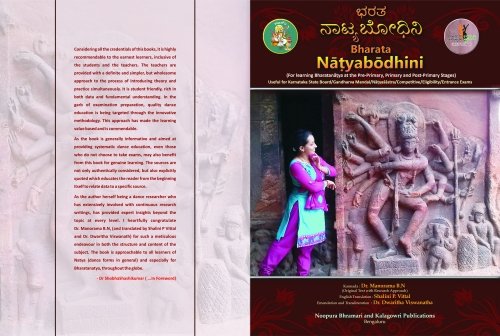
|   |

|   |
Bharata Nāṭyabodhini - Arjun Bharadwaj August 27, 2018  Today's
aspiring artists in general and dancers in particular are grappling
with access to resources that deal with the basics of their respective
forms of art, presented in an easily comprehensible manner. While honing
performance skills is one dimension of an artist, which is usually
aimed at perfecting the grammar of the art form, a thorough
understanding of aesthetics, classical literature, art history and the
life stories of artists of the past can enrich the content of the art
form. A remarkable attempt in this direction has been made by Dr. BN
Manorama, a thorough scholar of classical Indian dance and aesthetics
with an insightful understanding of the underlying philosophy and aided
by practical experience. Today's
aspiring artists in general and dancers in particular are grappling
with access to resources that deal with the basics of their respective
forms of art, presented in an easily comprehensible manner. While honing
performance skills is one dimension of an artist, which is usually
aimed at perfecting the grammar of the art form, a thorough
understanding of aesthetics, classical literature, art history and the
life stories of artists of the past can enrich the content of the art
form. A remarkable attempt in this direction has been made by Dr. BN
Manorama, a thorough scholar of classical Indian dance and aesthetics
with an insightful understanding of the underlying philosophy and aided
by practical experience. The work 'Bharata Nāṭyabodhini' released on 12th August 2018 in Bangalore can act as a stepping stone in a dancer's career by laying strong foundation in the fundamentals of the art form. The book is not only rendered in the Kannada language by the author, but is also accompanied by an English version, translated by Shalini P Vittal and Dr. Dwaritha Vishwanatha, both scholars and artists. The book has also been composed keeping in mind students who would like to appear for dance exams at different levels conducted by the Karnataka State Board, Gandharva Mandal and other nation-wide institutions. As mentioned by the author in the introductory essay, the outcome of the exam is merely a by-product of the process of going through the text. The bookitself is aimed at educating dancers about their own form of art, irrespective of their interest in appearing for the said exams. The book is a result of the deep scholarship and thorough research of Dr. Manorama spanning over ten years. It is evident in the rich flow of content and clarity of concepts presented in ornate Kannada language, which is also translated into simple English for the benefit of the global audience. The book starts with the etymological derivations of the word Abhinaya, and Bharata and also gives cultural connotations which are indivisible part of Indian ethos. An artist practising any form of Indian art cannot be successful unless he has a thorough understanding, an intuitive feeling and respect for the cultural elements. This has been dealt in detail in the opening chapters of the book. The purpose of Art, its creation, the responsibilities of an artist, the features of a dancer and the technical terms used are all described in detail by quoting from the original texts, mainly the Natyasastra of Bharata and Abhinaya Darpana of Nandikesvara. Dr. Manorama's research is intricately blended into the basics, in aspects such as identifying nrtta, nrtya and natya and the evolution of the system of adavus of Bharatanatyam. The origin of different styles of Bharatanatyam in Karnataka and a bird's overview of the different genres of dance forms of India make the learning wholesome. In the practical sections of the book, a detailed treatment of the yoga exercises is given as preliminary to learning of dance. It is followed by the description of different kind of adavus, hastas and the other aspects of angikabhinaya along with the original verses, their meaning and application. The descriptions are aided by visual representation of the movements using line sketches. Natya, being a composite art form, the aspects of vacika, aharya and sattvika abhinaya are also given detailed treatment. In addition to this, the book has chapters on the practical execution pattern of Bharatanatyam and defines the various aspects ranging from the Pushpanjali to Tillana. The chapters are organised by giving a timeline for the study of the contents and by dividing it into monthly modules to be covered progressively. On even a preliminary glance through the book, one can easily say that it will not only nourish a person learning the dance form but will also educate a connoisseur to make his art appreciation deeper. In this sense, the book can be said to be nartaka-sahrdaya-siksartham. It does not stop there and also opens up avenues for possibilities of research to an inquisitive mind. Barring a few shortcomings in the design and the language, the book is a treasure. As Dr. Shobha Shashikumar (a dancer and scholar par excellence) aptly points out in her foreword, the book does a tremendous job at blending together practise with theory. The systematic pedagogy presented only reminds us of the seminal work of Dr. Padma Subrahmanyam who rejuvenated the lost pedagogy and technique of the classical marga as set by Bharata. The book is optimally priced and we hope that all students and connoisseurs of dance put it to good use. The writer is a multilingual scholar (English, Kannada, Greek, German, and French), poet, expert in cultural studies and linguistics, author of several books, organiser and convener of many seminars and conferences fellow for many renowned govt institutions being a research scholar. He is at present working as Asst. Professor in Amrita University, Bangalore. Post your comment Unless you wish to remain anonymous, please provide your name and email id when you use the Anonymous profile in the blog to post a comment. All appropriate comments posted in the blog will also be featured in the site. |